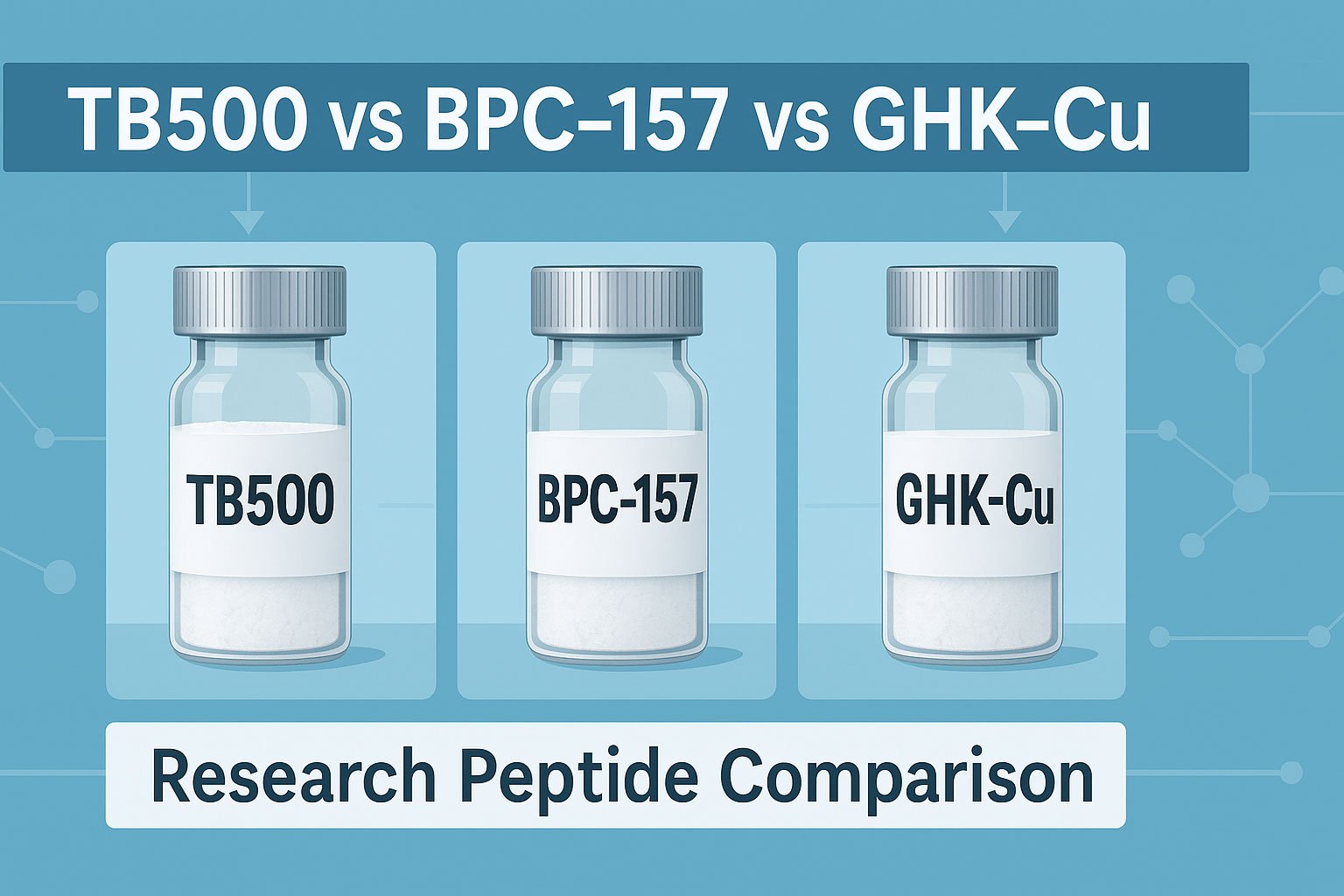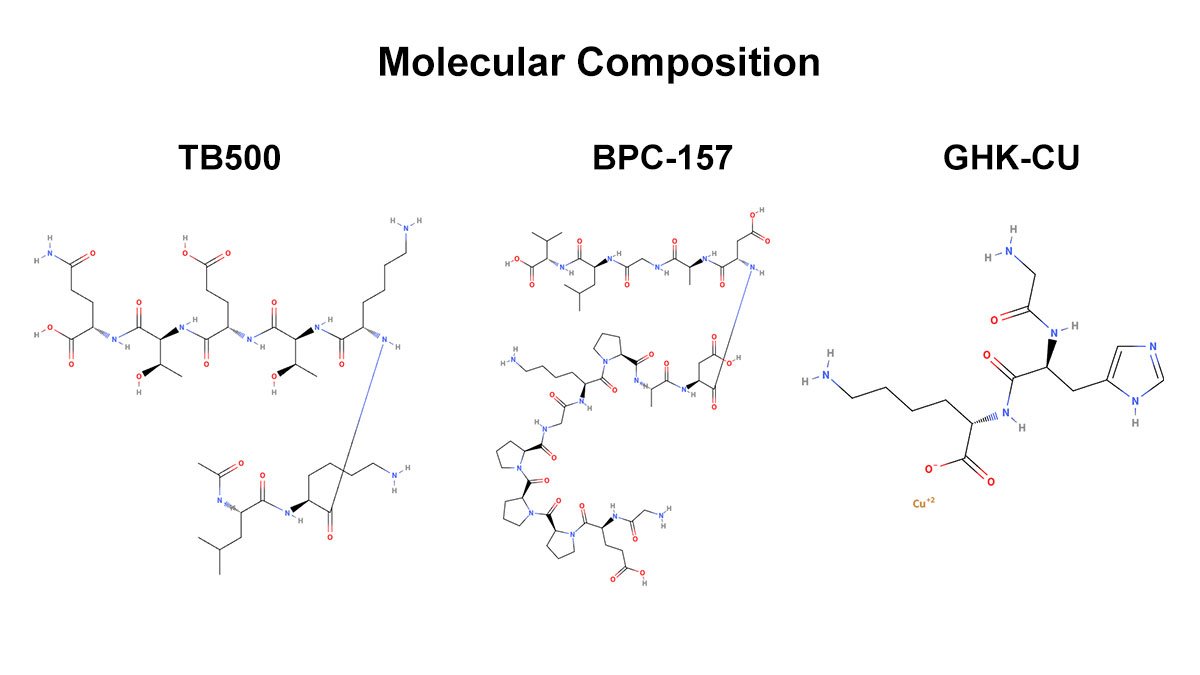- Peptide

Advanced Variable products with swatches
Products variations colors and images without any additional plugins.
- Organic Intermediates
- Inorganic Compound
- Cosmetic Raw Materials
TB500 vs BPC 157 vs GHK-Cu: Comparing the Top Peptides in Research and Recovery

Peptide research continues to grow in scope, especially in the fields of tissue repair, inflammation, and regenerative science. Among the most frequently explored peptides are TB500, BPC 157, and GHK-Cu. Each has shown unique potential in laboratory settings, but how do they compare?
In this article, we explore the key differences between TB500 vs BPC 157, and how both relate to GHK-Cu in research. Whether you’re studying soft tissue recovery, gut models, or skin regeneration, understanding these peptides can help you design more effective research pathways.
Note: All peptides mentioned are strictly intended for laboratory research use only and are not approved for human or veterinary applications.
What Are These Peptides?

1. TB500
TB500 is a synthetic peptide derived from Thymosin Beta-4. It’s commonly studied for its role in:
- Cell migration
- Muscle repair
- Angiogenesis (blood vessel formation)
Researchers often use TB500 in soft tissue or joint recovery models.
2. BPC 157
BPC 157 is a peptide fragment derived from gastric proteins. Known for its stability and versatility, it’s a popular subject in:
- Gastrointestinal protection
- Inflammation modulation
- Tendon and ligament recovery
It’s frequently used in vascular and soft tissue research models.
3. GHK-Cu
GHK-Cu is a tripeptide (Glycine-Histidine-Lysine) bound to a copper ion. Its research focus includes:
- Collagen production
- Skin remodeling
- Anti-aging studies
It’s especially common in cosmetic peptide and wound healing studies.
TB500 vs BPC 157: Core Differences
When comparing tb500 vs bpc 157, both have shown promise in soft tissue studies, but with different mechanisms:| Feature | TB500 | BPC 157 |
|---|---|---|
| Origin | Thymosin Beta-4 fragment | Gastric protein fragment |
| Focus | Muscle, joint, tissue | Gut, inflammation, vascular |
| Mechanism | Cell migration, actin binding | Nitric oxide modulation, angiogenesis |
| Stability | Good | Excellent |
| Common Research Use | Muscle and tendon models | Inflammation and gut healing |
These peptides are supplied as lyophilized powders and are intended for controlled lab environments.
Where Does GHK-Cu Fit In?
Unlike TB500 or BPC 157, GHK-Cu is mostly associated with skin and cosmetic research. Its role in gene expression makes it valuable in models involving:
- Wound healing
- Skin firmness
- Oxidative stress modulation
Some researchers use GHK-Cu in combination with TB500 or BPC 157 to evaluate their collective effects in complex healing pathways.
Summary Table: Side-by-Side Comparison
| Peptide | Main Focus | Mechanism | Research Areas |
|---|---|---|---|
| TB500 | Tissue repair | Cell migration, actin binding | Muscle, joint, angiogenesis |
| BPC 157 | Inflammation & vascular | NO modulation, protective pathways | Gut, soft tissue, tendon |
| GHK-Cu | Skin & collagen | Gene regulation, antioxidant | Skin aging, wound healing |
Storage and Lab Handling (Research Use Only)
| Peptide | Storage | Reconstitution | Stability |
|---|---|---|---|
| TB500 | -20°C, dry | Sterile water | Good |
| BPC 157 | -20°C, dry | Sterile water | Excellent |
| GHK-Cu | -20°C, protect from light | Water or acetic acid | Moderate |
Handle all peptides according to lab protocols. These products are not for human use.
How to Choose: Which Peptide Fits Your Research?
It depends on your research objective:
- Studying muscle recovery? → Consider TB500
- Exploring gut integrity or inflammation? → BPC 157 is a great choice
- Working on skin repair or cosmetic models? → GHK-Cu is most commonly used
Some laboratories also use multi-peptide blends to study complex tissue interactions. For example:
Popular Stack: GHK-Cu (50mg) + BPC 157 (10mg) + TB500 (10mg) + KPV (10mg)
Available in pre-mixed research formats. Contact us to learn more.
Frequently Asked Questions (FAQ)
Q: Can TB500 and BPC 157 be used together in research?
A: Yes. Many studies combine the two to explore enhanced effects on tissue regeneration and inflammation.
Q: What makes GHK-Cu different from TB500 and BPC 157?
A: GHK-Cu is primarily studied for skin health and anti-aging pathways, while TB500 and BPC 157 are more associated with soft tissue and inflammation.
Q: Are these peptides safe for personal use?
A: No. These compounds are for research use only and are not approved for human or clinical applications.
Final Notes & Compliance
All information provided here is for educational and research purposes only. None of the peptides discussed are intended to treat, diagnose, or cure any condition.
⚠️ Always follow local regulations and institutional guidelines when handling research peptides.



